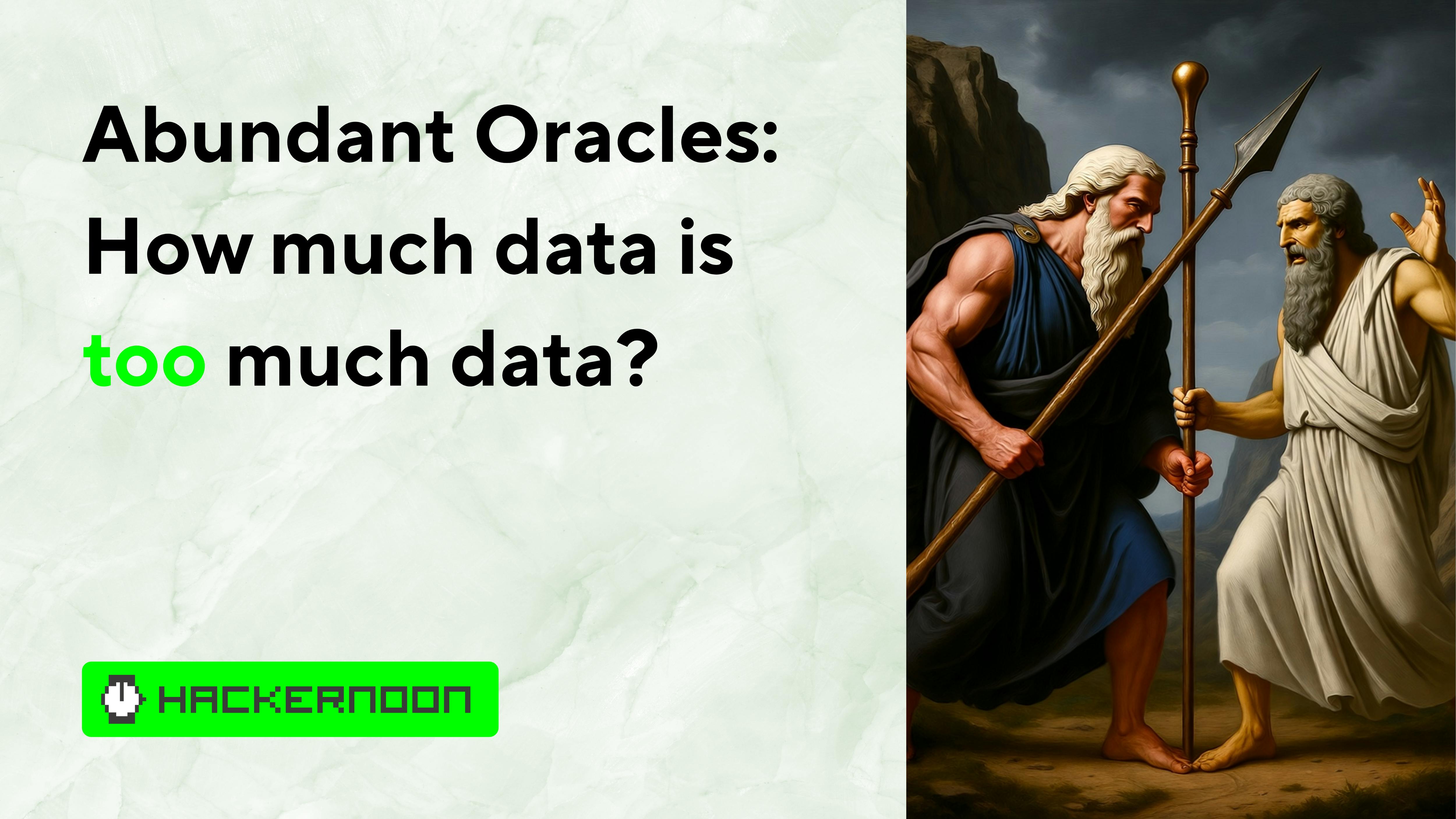AI is everywhere in marketing right now, embedded in tools, team goals, and executive strategies.
Executives are investing aggressively, headlines promise transformation, and tool stacks are expanding fast. But for most marketers on the ground, especially those working in social media, the actual impact of AI doesn’t match the hype.
According to research commissioned by Hootsuite and conducted by Censuswide in June 20251, 86% of senior marketing leaders and 79% of social media managers now use AI daily, but confidence in those tools is shaky.
Key takeaways
- AI adoption is high, but most tools miss the mark for social — only 39% of social media managers believe their AI uses real-time data.
- Instead of saving time, AI is adding to workloads. 43% of SMMs spend 11+ hours a week using AI tools, while nearly half still track trends manually.
- Trust is low: just 28% of social media managers believe their AI reflects what’s happening on social right now, forcing constant oversight and edits.
- Budgets are rising fast, but results lag. 40% of marketing leaders say they’ve wasted at least 10% of their AI spend on tools that didn’t deliver.
- OwlyGPT is purpose-built for social, with real-time insights, early trend detection, and content that’s ready to publish.
The misalignment holding teams back
There’s a disconnect between how leaders think AI is performing and how it’s actually landing on the front lines. 64% of senior marketers believe their tools use real-time data, but only 39% of social media managers agree.
That’s not a small gap. That’s a strategic misalignment. In a discipline like social, where timing, tone, and trust are everything, misalignment compounds fast.
The problem isn’t that AI lacks potential. It’s that most of the tools marketers are using weren’t designed for the platforms, content types, or pace of modern social. They promise automation but demand micromanagement. They surface information but lack context. And they’re trained on data that rarely reflects what people care about right now.
As AI budgets rise and expectations grow, the cracks are starting to show. The people closest to the work — closest to the platforms, the conversations, and the trends — know the truth: most AI tools can’t keep up.
And when your tools can’t keep up, neither can your team.
AI adoption is up, but social teams aren’t seeing the payoff. Instead of solving problems, most tools are creating new ones.
Here are three reasons AI is falling short, and what needs to change for social strategies to actually benefit.
AI isn’t saving time. It’s making work.
AI was pitched as the time-saver social teams have been waiting for. But in practice, it’s become a time sink, demanding hours of input, review, and rewriting before anything gets out the door.
43% of social media managers now spend more than 11 hours a week using AI tools. That’s a full third of their time spent coaxing content out of tools that were supposed to eliminate busywork.
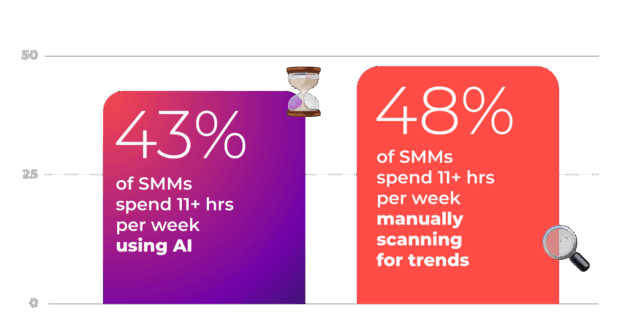
Most tools don’t handle trend discovery either. Nearly half (48%) of SMMs still spend over 11 hours a week manually scanning social platforms, and a quarter (25%) spend more than 16 hours. When AI can’t reliably surface what matters, teams are left to compensate, adding manual labor to an already overloaded workflow.
All of this effort might be worthwhile if the outputs were dependable. But they’re not.
A third of SMMs say they struggle to identify which trends are worth investing in, and another 27% say they usually spot them too late. That leaves social teams spinning their wheels — sorting through noise, watching competitors move faster, and questioning whether the hours spent with AI are helping or hurting.
And the impact climbs the ladder. 59% of senior marketers say their campaigns are launching after the trend window has closed. These delays aren’t about hesitation or bandwidth. They’re about visibility. Teams aren’t getting the right signals soon enough to act.
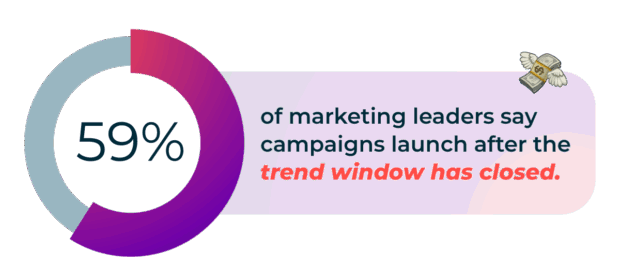
AI tools promise scale, but when they’re not tuned to the pace and nuance of social media, they just create more layers to manage. Outputs need editing, context needs verifying, and what’s supposed to be automation turns into another review cycle.
This isn’t an efficiency gain — it’s a redirection of effort. Teams are trading one kind of work for another, often with less confidence and slower results. And it’s not sustainable.
If your team spends double-digit hours each week on AI but still misses the moment, you don’t have a workflow; you have a workaround.
Your AI doesn’t understand social
Marketers know what great social looks like. The problem isn’t their judgment — it’s the tools they’re working with. Most AI wasn’t built for social. It pulls from outdated, general web content that doesn’t reflect how people actually talk or what’s trending in real time.
For a function like social, where context shifts hourly and cultural tone is everything, that foundation isn’t just outdated. It’s unusable.
43% of social media managers say the content they get from AI seems based on general web data rather than social-specific sources. The language feels off, the insights are shallow, and it reads like it was written by someone who’s never been online during a trend cycle.
That disconnect between what teams need and what AI tools provide shows up every day on the front lines.
When AI has a knowledge gap like this, teams have to compensate for that mismatch. 40% of social media managers say they regularly have to double-check or edit AI-generated content, not because the ideas are totally wrong but because the tone, timing, or references are out of sync with what’s happening right now.
This disconnect erodes trust. Only 28% of SMMs trust their current tools to reflect what’s happening on social media in real time.
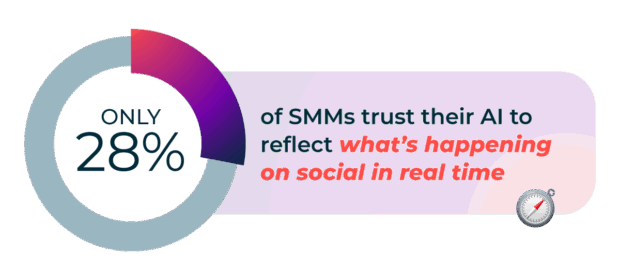
That’s staggeringly low, given that these tools are being used every single day by teams that know they can’t fully rely on them.
You’re not working with bad AI. You’re working with blind spots.
If your AI is drawing from stale sources, no amount of prompt engineering or internal upskilling will close the gap. You’re still starting from a disadvantage.
As Billy Jones, Head of Marketing at Hootsuite, puts it:
Most generative AI tools are already out of date the moment marketers use them. Traditional AI falls short for marketers who operate where their customers do: on social. If the insights aren’t grounded in what’s happening on social right now, they can’t drive real impact.
This is where frustration starts to look like failure, especially for marketing teams under pressure to move fast, create at scale, and hit performance benchmarks. It’s not that they’re not working hard enough; it’s that the tech is working against them.
The solution isn’t to pull back on AI. It’s to demand better from it.
AI spend is rising, but so are expectations
83% of senior marketers say their AI budgets have increased. Nearly half now spend over 10% of their total marketing budget on AI tools, and one in five (20%) are spending more than 20%. That kind of investment signals confidence — or at least urgency.
But confidence doesn’t guarantee impact. And pressure tends to follow spend.
AI budgets are under the microscope now: not because executives are anti-innovation, but because they’re still waiting to see the return. Teams were promised automation, scale, and speed. What they’re getting instead is a tangle of half-useful tools that often fail at the one thing they’re supposed to do: make social easier to execute and more effective to measure.
40% of senior marketers say they’ve wasted over 10% of their AI budget on tools that didn’t deliver, and more than a quarter say that number jumps past 20%. That’s not just disappointing. It’s career-risking in a climate where CFOs are scrutinizing every line item.

Those expectations create a dangerous dynamic for social teams. Instead of being freed up to focus on creative strategy or community building, they’re stuck justifying outputs, editing tone-deaf copy, or reverse-engineering performance from tools that can’t explain themselves.
Executives see the spend and expect results. Social teams see the tools and spot the cracks — slow outputs, shallow insights, and missed moments.
The risk here isn’t just a missed KPI. It’s the erosion of credibility. When teams can’t show clear wins from their AI investments, the perception shifts: not that the tools failed, but that the team did.
That’s why simply increasing AI spend won’t solve the problem. You can’t spend your way out of a mismatch. If your AI doesn’t understand what makes content resonate on social or can’t help you move fast enough to capitalize on a trend, then every additional dollar spent just adds pressure to prove ROI without giving you the tools to achieve it.
This is the inflection point. Marketing leaders have invested. Now they need tools that can deliver.
The problem isn’t AI itself. It’s the kind of AI most social teams are using.
Most marketing AI was never built for social. It pulls from static data sources, lacks real-time awareness, and can’t parse the nuance of how people speak online. It’s fluent in long-form blog tone, not TikTok subtext. It doesn’t understand when a post is driving engagement versus backlash. And it leaves social teams doing the heavy lifting.
That doesn’t mean social and AI can’t work together. But for that relationship to work, the tools need to be built with social at the core, not as an afterthought.
A truly social-first AI should be able to surface real-time signals, not just recycle last month’s headlines. It should flag emerging trends before they crest and help teams decide whether those trends are relevant, brand-aligned, and worth chasing.
Social-first AI also needs to understand tone and timing. It should know the difference between a fleeting meme and a lasting shift in audience behavior. It should recognize the cultural context that makes a campaign land or flop.
It should reduce friction, not add to it. Social teams shouldn’t have to rewrite every output, dig for missing citations, or manually cross-check references just to avoid posting something tone-deaf.
Here’s what that has to look like in practice:
- Surface what’s happening right now, not last week’s headlines
- Flag early-stage trends with context (not just keywords)
- Understand tone and timing, and the difference between memes and movements
- Deliver content that’s close to publish-ready, not first-draft filler
- Fit into your workflows — no rebuilding, no exporting, no guesswork
| Feature / Capability | Generic AI Tools 🛑 | Social-First AI (OwlyGPT) 🚀 |
|---|---|---|
| Data sources | 📰 Pulls from articles and forums | 🌐 Incorporates real-time social platform data |
| Trend detection | 🐢 Slow and retrospective | 🔍 Surfaces trends in real time |
| Tone awareness | 🧱 Generic, blog-like tone | 🎯 Designed to match platform tone and your brand voice |
| Content output | ✏️ Needs rewriting and cleanup | ✅ Close to publish-ready |
| Contextual insight | 🗂️ Basic outputs with little context or explanation | 💡 Surfaces insights with audience and cultural context |
| Workflow integration | 🔌 External, disconnected | 🔄 Integrated into Hootsuite workflow |
| Response to fast-moving trends | ⏰ Often lags or misses the moment | ⚡ Surfaces early trend signals with brand-aligned context |
| Trust from social teams | 🤷 Lower confidence from social teams | 🔐 Built for real-time accuracy teams can rely on |
This isn’t a wishlist. It’s a requirement. Because the pressure on social teams isn’t easing up, and the window to demonstrate AI’s value is closing.
If your current tools can’t deliver on that, it’s time to raise your expectations.
OwlyGPT: Because your other AI can’t keep up
Marketing’s AI moment is here — but most tools weren’t built for the front lines. OwlyGPT is.

OwlyGPT is purpose-built for social media marketing, using live social data to match the pace, tone, and pressure of today’s online conversations.
Where other tools guess at what’s trending, OwlyGPT shows you. It analyzes real-time conversations across platforms to surface what matters now, not last week or last quarter. And it doesn’t just hand you a list of hashtags or keywords. It gives you context, relevance, and direction, so you can decide what’s worth chasing and what’s not.
Because it’s built on live social signals, OwlyGPT reflects the tone, pace, and nuance of how people actually speak online. No more robotic copy that sounds like it was pulled from a B2B blog or rewriting AI content to match your audience. No more wasted hours editing half-right drafts into something usable.
Plus, OwlyGPT integrates directly into your existing workflows. You can prompt it for post copy, trend summaries, or campaign ideas without leaving Hootsuite.
OwlyGPT pulls platform-native insights in real time — like how your audience engages on Instagram — to help you move fast and stay relevant.
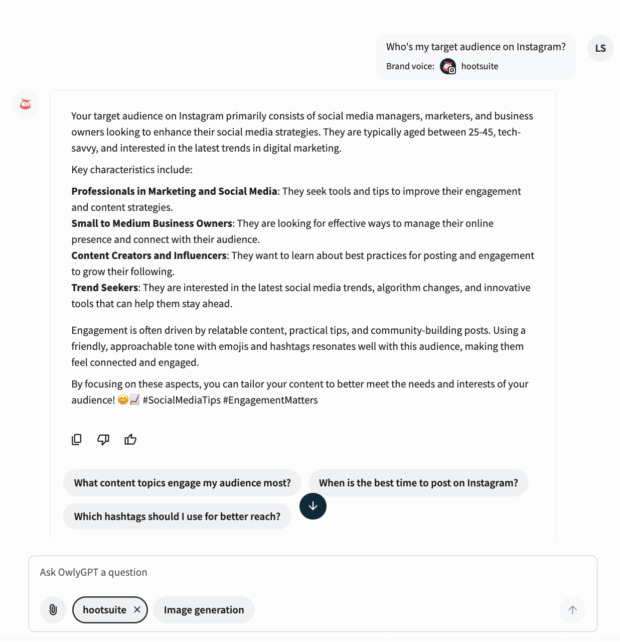
You can build content and gain insights directly from what’s happening in your space, with confidence that the data is current and the tone is right.
Social is one of the richest sources of real-time data available. And yet, traditional AI tools still can’t harness it. OwlyGPT turns insights from real-time social data into real business impact
OwlyGPT isn’t trying to replace your team’s creativity or strategic judgment. It’s here to remove the friction between insight and execution. To make it easier to spot opportunities, respond in the right voice, and get content out while it still matters.
That’s what social-first AI is supposed to do. And that’s what OwlyGPT delivers.
Still using AI that’s stuck in the past? OwlyGPT is the only social AI assistant trained on today — not the archives. It scours live social feeds to generate powerful insights and content based on what your audience is talking about online right now. Try it free today.
Why do many AI tools fail social media teams?
Many AI tools are trained on outdated or generic web data, not real-time social conversations. As a result, they can miss trends, tone, and timing — three things social teams can’t compromise on.
What’s the biggest gap between leaders and social media managers when it comes to AI?
64% of senior marketers believe their AI tools use real-time data, but only 39% of social managers agree — a major misalignment that shows how different the front-line experience is.
Does AI actually save social media managers time?
Not always. In fact, 43% of social media managers spend more than 11 hours a week working with AI tools, and many still track trends manually. Instead of reducing workload, AI often adds to it.
Why is trust in AI so low among social teams?
Only 28% of social media managers trust that AI reflects what’s happening on social in real time. Content often needs heavy editing because tone and context are off.
What are the benefits of social-first AI?
A social-first AI can surface real-time signals, flag early trends with context, understand tone and timing, and deliver content that’s close to publish-ready, without adding extra manual work.
How is OwlyGPT different from other AI tools?
OwlyGPT is purpose-built for social media. It uses live social data, reflects a platform-native tone, surfaces trends early, and integrates directly into Hootsuite workflows so teams can move faster and with more confidence.






